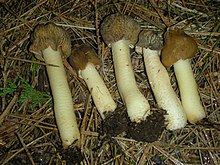Verpa conica
| Verpa conica | |
|---|---|

| |
| Scientific classification | |
| Domain: | Eukaryota |
| Kingdom: | Fungi |
| Division: | Ascomycota |
| Class: | Pezizomycetes |
| Order: | Pezizales |
| Family: | Morchellaceae |
| Genus: | Verpa |
| Species: | V. conica
|
| Binomial name | |
| Verpa conica (
Sw. (1815) | |
| Synonyms[1] | |
| Verpa conica | |
|---|---|
| Glebal hymenium | |
| Cap is ovate | |
| Hymenium is free | |
| Stipe is bare | |
| Edibility is edible but not recommended | |
Verpa conica, commonly known as the bell morel or the early morel, is a species of
Taxonomy
The species was first described under the name Phallus conicus by Otto Friedrich Müller in 1775. Later authors have moved the taxon to various genera: Persoon placed in Leotia in 1801, Samuel Frederick Gray transferred it Relhanum in 1821, while Otto Kuntze moved it to Monka in 1898. The species was transferred to Verpa by Olof Swartz in 1814.[1]
Description
Fruiting bodies have a smooth cap that is bell-shaped or conical, and 1 to 4 cm (3⁄8 to 1+5⁄8 in) tall and broad;[2][3] it is attached to the top of the stipe only, the margin of the cap is free – hanging like a skirt. The underside of the cap is tan to dark brown in color. The stipe, which measures 2 to 12 cm (3⁄4 to 4+3⁄4 in) by 1 to 3 cm (3⁄8 to 1+1⁄8 in) thick, is whitish[4] and either equal or slightly thicker than the base;[3] the stipe surface is either smooth or slightly fuzzy.[5] It is generally hollow, although young specimens may be filled with cotton-like hyphae. The flesh is thin and brittle, and the cap can be easily broken off the stipe.
David Arora notes that sometimes a variety with a wrinkled cap can be found, somewhat resembling a Gyromitra.[6]
Microscopic features
The
Similar species
Since the cap is free in V. conica, it is easily distinguishable from true
Other similar species include Verpa bohemica, which has a more wrinkled cap,[8] Morchella semilibera,[3] and species of Phallus, which smell of garbage or rotten meat.[8]
Habitat and distribution
The species can be found in North America from the West Coast (from March to June) to the Northeast (from April to May).[8]
It grows singly, scattered, or in groups on the ground in both
Uses
As a food product

Verpa species should always be cooked thoroughly and, if being eaten for the first time, restricted to small portions to test tolerance.[9][10][11]
As an antioxidant
There is evidence that V. conica may contain compounds that function as an
References
- ^ a b "Verpa conica (O.F. Müll.) Sw. 1814". MycoBank. International Mycological Association. Retrieved 2011-05-06.
- ^ Kuo M (January 2005). "Verpa conica". MushroomExpert.Com. Retrieved 2011-05-06.
- ^ OCLC 797915861.
- ISBN 978-0-88192-935-5.
- ISBN 978-1-58729-627-7.
- ^ ISBN 0-89815-169-4.
- ^ ISBN 0-89301-062-6.
- ^ ISBN 978-0-593-31998-7.
- ISBN 0-7112-2379-3.
- ISBN 0-472-85610-3.
- ISBN 978-1-55407-651-2.
- .
